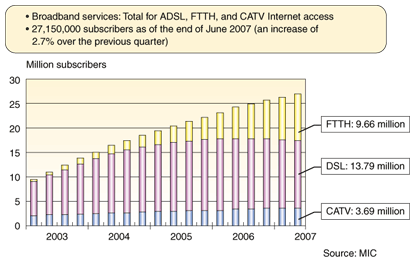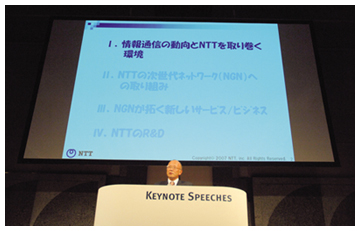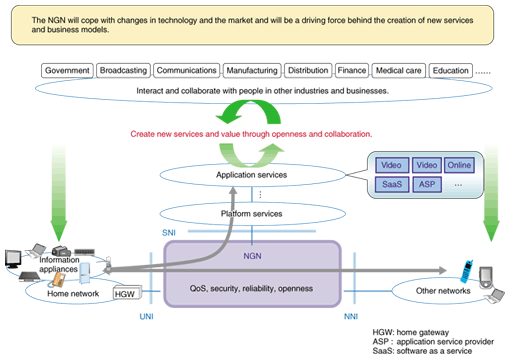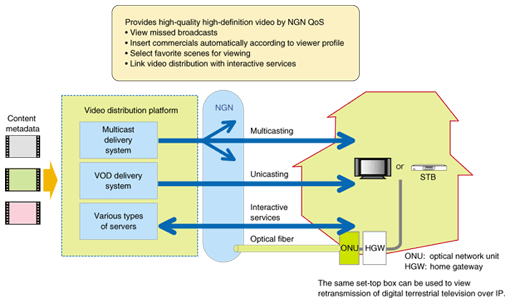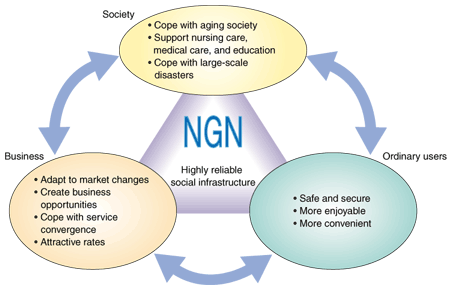 |
|||
|
|
|||
|
Lecture Spot Vol. 5, No. 12, pp. 1–7, Dec. 2007. https://doi.org/10.53829/ntr200712lc1  NGN: The Key to a Ubiquitous Broadband SocietyOverviewAs information and communication technology (ICT) continues to advance, we are seeing a flattening of the information-sharing mechanism and dramatic changes in the social structure. To provide a highly reliable social infrastructure that can cope with these changes, NTT is working on the construction of a next-generation network (NGN) and making preparations to provide safe and enjoyable NGN services. This article, which is based on a lecture given on October 3, 2007 at CEATEC JAPAN 2007, describes key technical features of the NGN and presents application examples. 1. Trends in information communications and the business environment surrounding NTT1.1 Overall industry trendsThe market for information-communication services in Japan has been undergoing constant change, and the last ten years, in particular, have been extremely dynamic. The area that has grown the most has been mobile communications, where the number of mobile subscribers has already exceeded 100 million. There were 103,070,000 subscriptions as of the end of June 2007. The market for IP (Internet protocol) telephony has also been increasing steadily, reaching 15,280,000 subscriptions as of the same date. On the other hand, the market for fixed-line and ISDN (integrated services digital network) services has been on a downward trend, falling to 54,220,000 subscriptions. Also of interest here is the number of Internet subscribers, which, at more than 120 million, exceeds the number of mobile subscribers. According to statistics compiled by the Ministry of Internal Affairs and Communications (MIC), the population of Japan is about 127 million people (as of September 2007), meaning that the number of Internet subscribers is almost equal to the total population. Of course, some people have multiple subscriptions, while others have no subscriptions. The number of Internet subscribers includes 27,150,000 subscribers to broadband services (which, in Japan, are defined as communication lines having a bit rate of 500 kbit/s or higher) broken down as 3,690,000 subscribers to CATV (cable television), 13,790,000 to DSL (digital subscriber line), and 9,660,000 to FTTH (fiber to the home). In the last one to two years, CATV and DSL have stagnated while FTTH has been experiencing vigorous growth (Fig. 1).
1.2 NTT's broadband servicesAlthough DSL has yet to be surpassed in Japan's overall communications market, it was overtaken by FTTH within the NTT Group in January 2007. Tabulations performed at the end of August by NTT West and NTT East revealed that the number of NTT FTTH subscribers increased to 7,210,000 (59%), while the number of DSL subscribers decreased to 5,090,000 (41%). A similar phenomenon appeared in the mobile market, with the share of NTT DoCoMo FOMA*1 users surpassing that of mova*2 users. As of the end of August 2007, the number of mova subscribers had dropped to 13,560,000 (26%), while the number of FOMA subscribers had increased dramatically to 39,340,000 (74%). 1.3 Domestic and international trends in broadband servicesOne outstanding feature of telecommunication services in Japan is low rates. Compared with major cities around the world, the DSL and FTTH services provided in Tokyo are the most inexpensive in terms of monthly fees and price per 1 Mbit/s. While there is much activity in broadband services throughout the world, much diversity can be found with regards to market background and environment. In the USA, for example, broadband access by CATV is very strong, while in Europe, DSL boasts an overwhelming share. In Japan, FTTH has 35.6% of the overall broadband market compared with 1.1% in the USA and less than 1% in countries like the U.K., France, and Germany. It can therefore be seen that the pace of FTTH expansion in Japan's broadband services has been extremely fast, even from an international viewpoint. In short, FTTH services in Japan are expanding at the fastest pace and have the lowest price levels in the world. 1.4 Flattening of information sharingTogether with advances in the information-communications environment, we can see an expansion of consumer generated media in the individual domain and an increase in collaborative business in the corporate domain. As individuals come to publish information with increasing frequency and the horizontal ties between companies intensify, the mechanism of information sharing is shifting from one characterized as closed-minded, centralized, unidirectional, and static to one that is increasingly open-minded, distributed, bidirectional, and dynamic. The boundary between the information-publishing and information-receiving sides is blurring and the shape of information sharing is becoming flat. As a result, the Web 2.0 feature of information dissemination from diverse entities and knowledge sharing is progressing, and information published by both individuals and companies is coming to have a significant effect on social economic activities. This diverse and abundant amount of information is becoming an energizing force behind social economics. 1.5 Structural changes in society caused by ICTStructural changes in society brought about by the evolution of ICT are moving in three major directions.
(1) Service convergence: linking and convergence of broadcasting and communications, convergence of fixed and mobile systems, convergence of terminals (personal computers, TVs, cell phones), etc.
(2) New trends in net business—rapid progress of Web 2.0: user participation, open-minded, long-tail phenomenon, etc. (3) Globalization of business and issues: globalization of corporations, manifestation of global issues, etc. These changes in the social structure and changes in business models owe much to interaction with ICT. In short, ICT is playing an extremely important role in social change. Rapid globalization, in particular, is having a huge effect on society. We are now in a period of intensive reform that aims to knock down the barriers of time and distance and eliminate the uneven distribution of knowledge.
2. NTT's stance toward the NGN2.1 NTT Group's Medium-term Management StrategyNTT, which aims to play an important part in the creation of a ubiquitous broadband society, is promoting the development of an open network and diversified services in line with the Japanese government's e-Japan strategy and u-Japan policy. The NTT Group's Medium-term Management Strategy of 2004 proclaims the following three objectives.
(1) Achieve a ubiquitous broadband society to create a rich communication environment for individuals and the community and to make business activities more efficient and create new business opportunities for the corporate world.
(2) Construct an open network environment in which a wide variety of players and diverse services can thrive through the active cooperation and support of the NTT Group. (3) Increase the corporate value of the NTT Group through these efforts and contribute to corporate profits for the benefit of all shareholders and investors. And more specifically, NTT aims to construct an NGN and develop ubiquitous broadband services as two pillars on which to provide several tens of millions of fixed-line customers with NGN optical services by 2010FY (the end of March 2011). NTT also aims to modify the profit structure in conjunction with the development of an NGN. In recent years, the telecommunications business of the NTT Group has been experiencing a decline in revenues from voice-related communications (both fixed and mobile), and even revenues from the rapidly growing broadband field are not expected to cover this shortfall. In response to this situation, NTT plans to expand in the broadband field through the development of sophisticated services on the NGN. 2.2 NGN: the third networkThe main functions required of a telephone network, i.e., the starting points of a telecommunications business, are high-quality voice-centered services, emphasis on reliability and stability (lifeline capable), and operation as a public network. A telephone network is centrally managed to provide services that consider safety and security to be of prime importance. On the other hand, the features most desired on the Internet are convenience and enjoyment. The Internet's advantages are diverse ubiquitous and broadband services and content, emphasis on economic efficiency, and unlimited extendibility through a distributed open network. In light of the above, the full-IP NGN was conceived as being the third network that will combine the merits of the telephone network and the Internet. Its main features are that it inherits the quality and reliability achieved during the development of the fixed telephone network, uses IP technology appropriate for broadband systems, solves past issues like security measures, and broadens the choice of services. The NGN maintains the reliability and stability of the telephone network and the flexibility and extendibility of the Internet. A common misperception, however, is that the NGN is meant to replace the Internet, and debates in the form of NGN versus the Internet are often held. This is a mistaken view. The Internet and NGN can, we believe, be isolated from each other and coexist. 2.3 NGN technical featuresSo how then does the NGN differ from the telephone network and the Internet? The following four points can be offered as technical features of the NGN. (1) Quality of service The Internet is basically a best-effort network, which means that problems such as dropped calls, interference with information, or slow display of information at times of congestion are not rare occurrences. The NGN, in contrast, provides four quality of service (QoS) classes: highest priority, high priority, priority, and best-effort. The user can select a suitable QoS class according to the communication procedure determined for each application. (2) Security To counter ever-increasing net crime, the NGN provides high-level security functions. Communication-control servers that control edge nodes at network entrances will manage identification information on each circuit and check originator IDs (identification numbers). This will enable the system to block fraudulent use of another person's telephone number and other forms of spoofing as well as unauthorized access, unusual traffic, and so on at edge nodes. (3) Reliability The NGN will feature network construction designed to handle a variety of conditions including natural disasters and abnormal concentrations of traffic. In addition to using technical know-how in safety and security inherited from telephone network development, the NGN will switch equipment and reroute circuits at the time of system faults using redundant network configurations and will maintain network functions at times of congestion by implementing traffic-control measures and ensuring critical communications. (4) Open interfaces To achieve services with a high degree of freedom, the NGN will provide abundant communication functions including multicast communications for IP broadcasts, unicast communications for video on demand (VOD), interactive communications for providing voice and video data, Internet connections, and Ethernet services. To enable effective use of these functions and raise the level of network openness, NTT is disclosing specifications for the interfaces between one network and another network (NNI), between a user and a network (UNI), and between an application server and a network (SNI). The protocols used by these interfaces conform to international standards such as those established by the ITU-T (International Telecommunication Union Telecommunication Standardization Sector) and IETF (Internet Engineering Task Force) as well as to domestic standards such as those established by the Telecommunication Technology Committee (TTC). 2.4 Roadmap to NGN commercializationIn March 2006, NTT released an outline of field trials to be held with the aim of deploying and commercializing the NGN. In July of the same year, NTT disclosed the interfaces and began recruiting participants. The trials began in December 2006. The plan is to begin genuine provision of NGN services in the second half of fiscal year 2007. The NGN is considered to be an evolving network and we envision the creation and deployment of many new services as it continues to evolve in the years to come. 3. New services and businesses through the NGN3.1 Openness and collaborationNeedless to say, the development of NGN business cannot be accomplished solely by the NTT Group. As mentioned above, the NGN has three main interfaces. If their specifications were not disclosed, it would be impossible to connect with users, other networks, and other applications. The NGN will lead to the creation of new services and added value as interfaces are disclosed to open up connections with other networks and as collaborative relationships are formed to break down the walls between different types of businesses and industries (Fig. 2).
3.2 Field trial examplesMany business operators are participating and collaborating in the field trials that commenced in December 2006. For example, 14 information-appliance vendors and content and broadcasting companies are testing application services while 15 carriers and ISPs are testing Internet connections and performing interconnectivity experiments. The following are specific examples of field trials now being held. (1) Telepathology system Since NGN technology will be able to ensure a high level of quality and security, we can expect the NGN to make significant contributions to fields related to medical care. For example, we can envision stable high-definition video communications supporting remote pathological diagnosis. In such a system, a medical specialist would be able to remotely and accurately manipulate a microscope to view a high-definition video image of an extracted pathological sample and make an immediate diagnosis. (2) Data distribution for digital cinema The QoS and high-reliability features of the NGN can be exploited to distribute data for digital cinema (a video distribution and display system free of analog film). The traditional method of distributing a movie to theaters for public showing is to print a copy of its digital master, make as many copies on film as needed, and physically transport that film to the theaters. Digital cinema, in contrast, does not use film at all. If we consider a work completed in Hollywood (in the USA), for example, the system would deliver the movie data and encryption key data from Hollywood to a content server and key data server, respectively, at a distribution center somewhere within Japan and then distribute that data to each of the theaters showing the movie through the use of NGN Ethernet communication functions. (3) High-definition IPTV service One application that can use NGN functions to great effect is a high-definition video distribution service via IPTV (Internet protocol television). This system will distribute high-quality high-definition video by utilizing the NGN's QoS functions via a video distribution platform consisting of a multicast delivery system, VOD delivery system, and various types of servers (Fig. 3). With this system, video can be distributed by optical means even to areas that are unable to receive TV signals.
(4) Hikari authentication service Multifactor authentication that uses a combination of authentication techniques to enhance security has been attracting much attention. The use of multiple authentication schemes, however, increases the burden on the user while increasing system costs and adding complexity. Hikari*3 authentication solves these problems by combining NGN circuit-identification information with other authentication techniques. Since an authentication process based on circuit-identification information is already provided on the network side, robust security can be maintained without increasing the user or system load. (5) Ubiquitous (network services for kid's safety) A ubiquitous monitoring service allows parents and guardians to monitor children on their way between school and home from a terminal installed at home or elsewhere. One feature of such a service is that it makes great use of mobility in a way that only a ubiquitous system can. However, the privacy of the individuals being monitored is an issue of concern. In contrast, ubiquitous monitoring by the NGN accurately latches onto the target to be monitored—whether that is a person or object—and provides realtime, high-quality video of the target while maintaining privacy by linking IC-tag (tag containing an integrated circuit) detection with video cameras through authentication based on originator ID and quality assurance based on QoS. In short, ubiquitous monitoring by the NGN creates an environment in which a person that needs to be seen is accurately monitored only when viewing is necessary.
3.3 Showroom NOTENTT is exhibiting and introducing key examples of these field trials at its NGN Open Trial Exhibition (NOTE) showroom in Otemachi, Tokyo. Since its opening in December 2006, NOTE has welcomed about 16,000 visitors (as of the end of August 2007), including 324 overseas guests from 41 countries. Questionnaires given to visitors viewing the NOTE exhibits revealed that just under 80% felt that they “understood the outline of the NGN” and that just over 80% felt that “life and business would be changed by the NGN” (survey period: August 27 to September 4, 2007; number of respondents: 300). The three most interesting exhibits from the viewpoint of visitors were found to be:
3.4 NGN as a social infrastructureIn places that involve human life, such as medical-care facilities, or at times of natural disasters or other emergencies, the social infrastructure must be reliable and instill confidence in users. It must also be simple enough that anyone can use it regardless of technical skills. The NGN, which can provide a broadband, ubiquitous, and secure environment to a broad user base including society, business, and ordinary users, is generating high expectations as a reliable social infrastructure (Fig. 4).
In society, there is a need for services that can cope with the aging population, support nursing care, medical care, and education, and cope with large-scale disasters, while in the business world, there are demands for services that can adapt to market changes, create business opportunities, and cope with service convergence and provide attractive rates. As for ordinary users, they want more enjoyable and more convenient services that are also safe and secure. Services that meet these requirements can be provided through the use of the NGN. 4. NTT R&DAt present, R&D at NTT is guided by the following three policies.
Befitting its reputation as a front runner in optical services, the NTT Group is taking a worldwide leadership role in both adapting to the era of large-scale deployment of optical services and maintaining, managing, and operating optical services. The NTT Group is also developing access-system technologies for achieving the above, and it is developing technologies for creating new NGN-based services to provide users with a large number and variety of application services in simple and convenient ways. In addition, R&D at NTT continues to pursue a variety of projects while looking forward and envisioning the shape of things to come. 5. Toward the 2008 launch of NGN servicesThe field-trial is progressing well, and genuine NGN services are scheduled to begin next year, at long last. In this way, NTT hopes to make an even greater contribution to the advancement of ICT in Japan while forming collaborative relationships with other relevant business enterprises. |
|||








